Latissimus dorsi can be translated as “the broadest muscle of the back.” True to its name, latissimus dorsi is one of the most important muscles to train for a stronger and broader back. Thus, it becomes the primary goal for many athletes and bodybuilders.
The latissimus dorsi is a large, flat muscle on the back that stretches to the sides, behind the arm, and is partly covered by the trapezius on the back near the midline.
The clinical significance of lats overcomes even the aesthetic part. It is an essential support for the cardiovascular system and the general injury-eliminating element. A Frech study has proven the effectiveness of latissimus dorsi training on the function of the heart and skeletal muscle metabolism. Even to the point of providing latissimus dorsi exercises for patients before cardiomyoplasty.
The everyday functions of the muscles start with keeping your torso upright up to assisting the breathing process and every active movement in between. Weak or injured latissimus dorsi brings problems with raising arms, body rotation, and cardio issues. Thus, I’d like to highly the importance of latissimus dorsi training outside of the aesthetic perspective both for men and women.
Latissimus dorsi is responsive for adduction, extension, flexion, and internal rotation. The impressive size of the muscle provides it proper engagement during most compound exercises focused on the back. However, while its basic functions provide it proper movement throughout the day, only the targeted exercises can strengthen it. Plus, hypertrophy requires more attention than general compound movements.
This is why I’ve gathered 11 bet lats exercises for you in this article. Not all of them are suitable for beginners, but you can find plenty of options for all levels of fitness enthusiasts. You should also one yoga exercise for lats for your active rest days – Warrior 2 Pose (Virabhadrasana 2).
Row
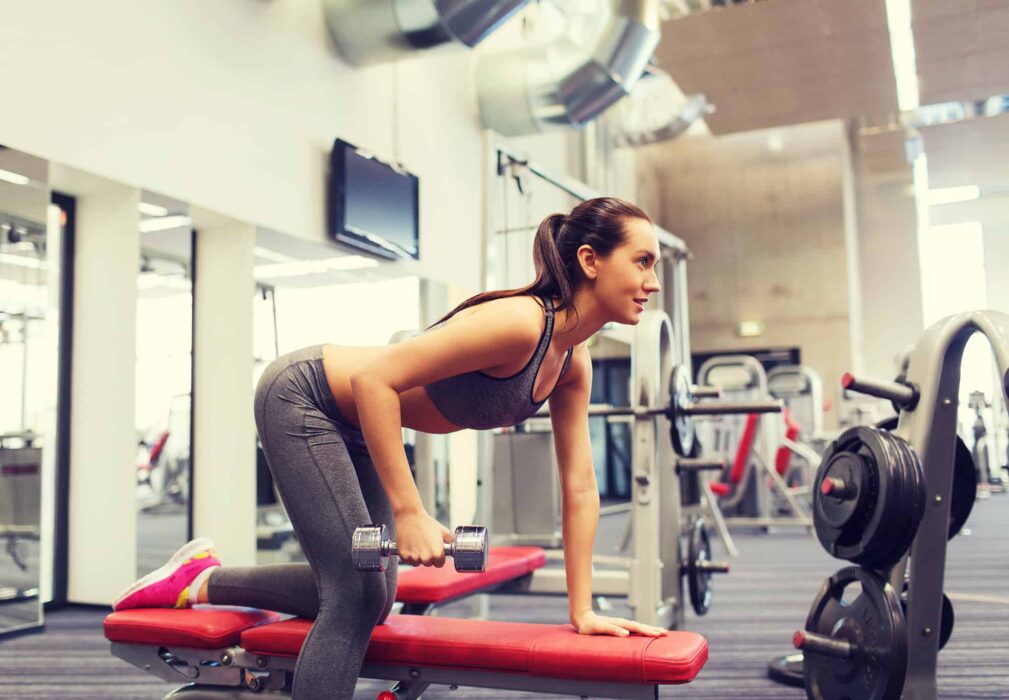
Be prepared to see many rowing exercises in this article! They are really the most effective for lats. First, let’s start with the basic row.
A dumbbell row is an excellent exercise for a stronger back and toned muscles. It engages the following muscles:
- latissimus dorsi (which is our target!)
- teres major
- posterior deltoids
- trapezius
- rhomboids
The following compound exercise effectively loads back muscles and burns more calories than isolated exercises. A dumbbell row includes a wide range of motion that also positively affects shoulder and elbow mobility.
11 Best Upright Row Alternatives (Home and Gym Versions)
If you are still a beginner with weak lats, take this exercise with caution and don’t load too much weight.
How to do:
- Stand with your feet hip-width apart near a bending bench. Bend your knees slightly.
- Place the non rowing hand and the same knee onto the bench. Make sure your back is flat.
- Reach down with the “working” hand and take the dumbbell. Straighten to the previous position. Keep your neck neutral during the movement.
- Squeeze your shoulder blades together and retract your elbow up and behind. The full range is reached when your elbow moves past the shoulder, and the dumbbell reaches your hip level.
- Slowly lower the dumbbell back down.
Deadlift

The deadlift is a compound exercise that trains your whole upper body, plus the lower as well. However, it may seem that lats get the least amount of load. However, the deadlift is a functional exercise that engages muscles in the most effective way. For each group!
Deadlift engages:
- gluteus maximus
- quadriceps femoris
- hamstrings
- trapezius
- lats (bingo!)
- erector spinae
How to do:
- Stand with feet hip-width apart and take dumbbells in your hands.
- Engage your core and slowly lower dumbbells close to the floor. Make sure your back is straight (lean forward), neck neutral, and your hamstrings are stretched.
- Slowly rise in the previous position.
Well done! This is one rep. Repeat as needed. Make sure you don’t feel pain n the back with doing the exercise.
Dumbbell Superman (With Lat Row)
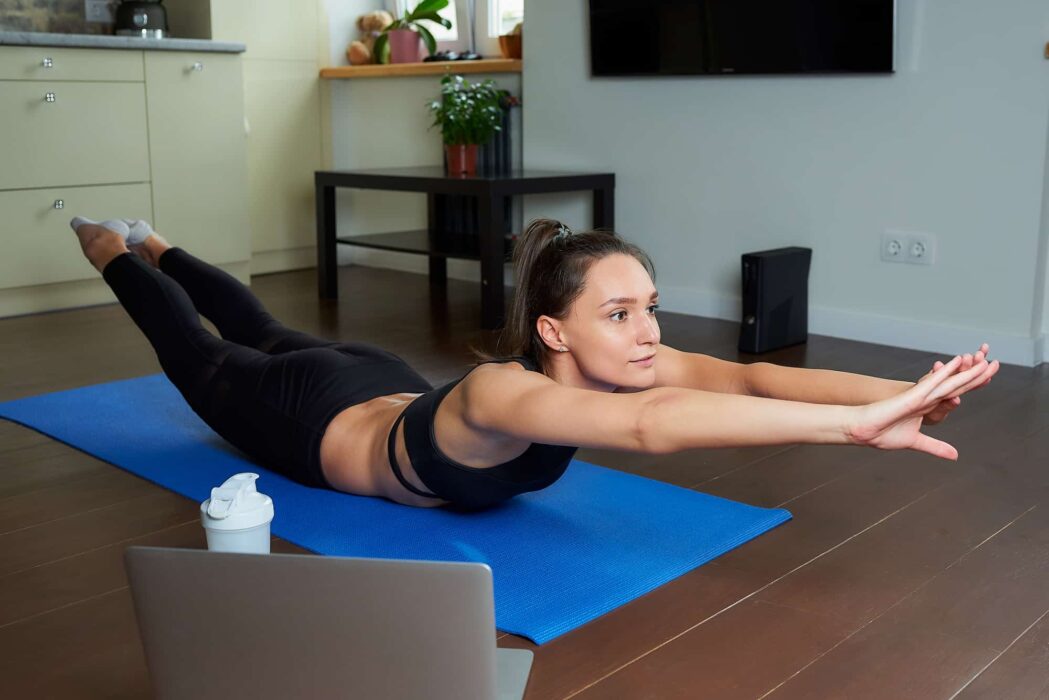
This variation of dumbbell Superman brings the focus to your lats by loading it better. This is not a highly common exercise that you’ll see in gyms. Among the benefits of a regular Superman are stronger back and spinal health. With this version, you get a wider back as well.
It targets:
- back muscles
- hamstrings
- glutes
- core
How to do:
- Lay face down on the floor. Feet hip-width apart.
- Stretch your hands forward and take dumbbells in each. (Go for lighter options!).
- Slowly lift your legs from the floor for around six inches. At the same time, raise your hands from the floor for just an inch; bend your elbows and tuck them close to your torso.
- Lower your legs and straighten your hands again.
Important: Do not go for heavy weights in this exercise, and don’t bend too much your lower back. Also, make sure that your neck is kept straight in a neutral position.
5 Best Tricep Workouts With Dumbbells
One-Handed Dumbbell Twist Row
This exercise engages:
- Latissimus Dorsi
- Teres Major and Minor
- Rhomboids
- Infraspinatus
- Middle and Lower Trapezius
- Posterior Deltoid
- Lower Pectoralis Major
- Brachialis
- Brachioradialis
- Obliques
- Biceps
- Triceps
Now you know that this exercise shouldn’t be easily dismissed.
How to do:
- Stand with one foot forward. The working hand will be the opposite of it. Bend your knees substantially.
- Take a dumbbell in the working hand. Bring it up to your chest, elbow also up.
- At the end of the motion, twist your torso outwards after the rising hand. Be sure you feel no back pain during this movement.
- Pause for a second and lower the dumbbell to the starting position.
Move your “passive” hand slightly forward when you lift the dumbbell to keep the perfect balance.
Bent-Over Row
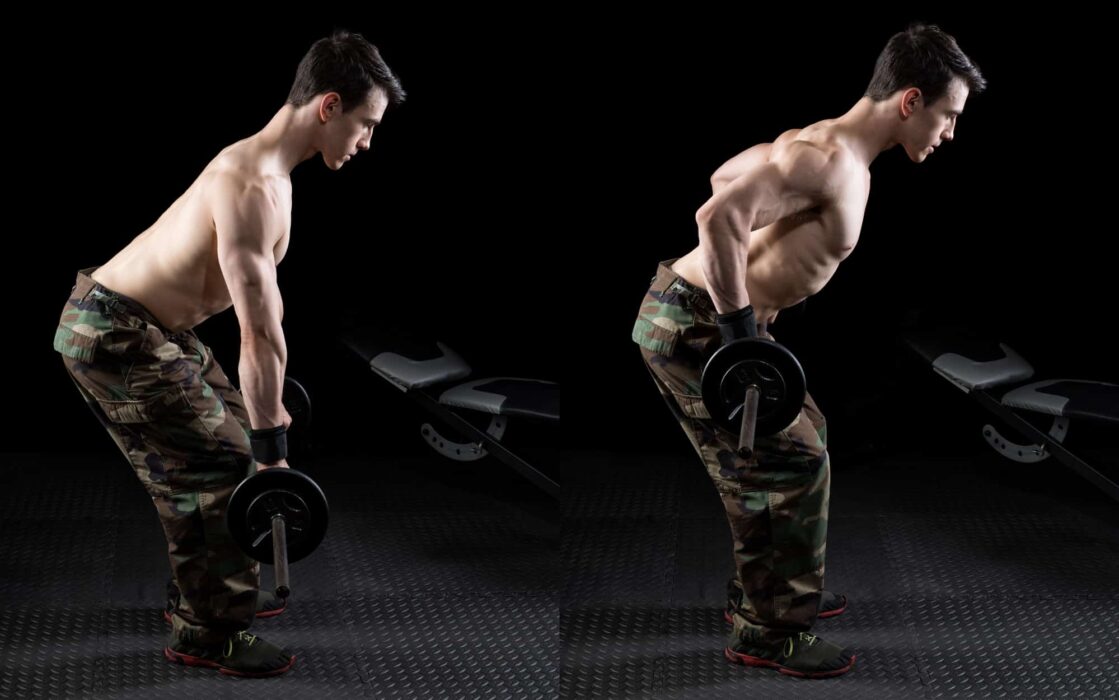
The bent-over row is quite similar to the regular row and targets similar mack muscles. However, it puts more strain on the body, thus working those muscles even better.
Bent-over row targets:
- trapezius
- infraspinatus
- rhomboids
- latissimus dorsi (this is why we are here)
- teres major and minor
This list offers an impressive back workout! Don’t miss this exercise.
How to do:
- Stand with your feet hipe (shoulder) width apart. Knees somewhat bent.
- Take dumbbells in each hand.
- Bend your torso to 45 degrees. Keep your back and neck straight.
- Pull up the dumbbells to the sides of your chest. The maximum amplitude is elbows parallel to shoulders.
- Slowly lower the dumbbells.
Reverse Fly
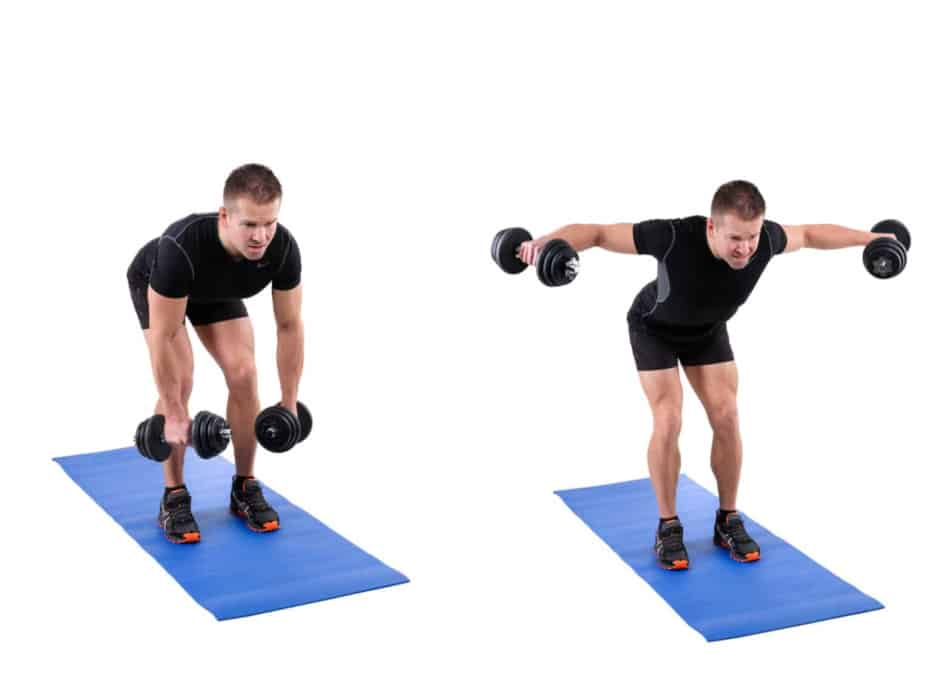
This one is a very interesting exercise! You can do it both with the use of a special incline bench in the gym or simply at home with minimum equipment – dumbbells only. In both cases, the exercises will be just as effective.
Muscles engaged:
- triceps
- deltoids
- lateral deltoids
- rhomboids
- infraspinatus muscle
How to Master Dumbbell Romanian Deadlift for Beginners
How to do: (home version)
- Stand with feet shoulder-width apart. Take a dumbbell in each hand.
- Bend your torso to around 45 degrees and hinge your hips back slightly. The back should remain straight.
- Turn your palms to face each other. Elbows slightly bent.
- Squeeze your back muscles and raise your hands to the side until they parallel your shoulders. Do not raise higher! Especially with added weights. Remember to keep elbows bent.
- Pause for a send and lower arms back down.
Remember that this is a strenuous exercise for your shoulder muscles – take lighter dumbbells.
Dumbbell Pullover
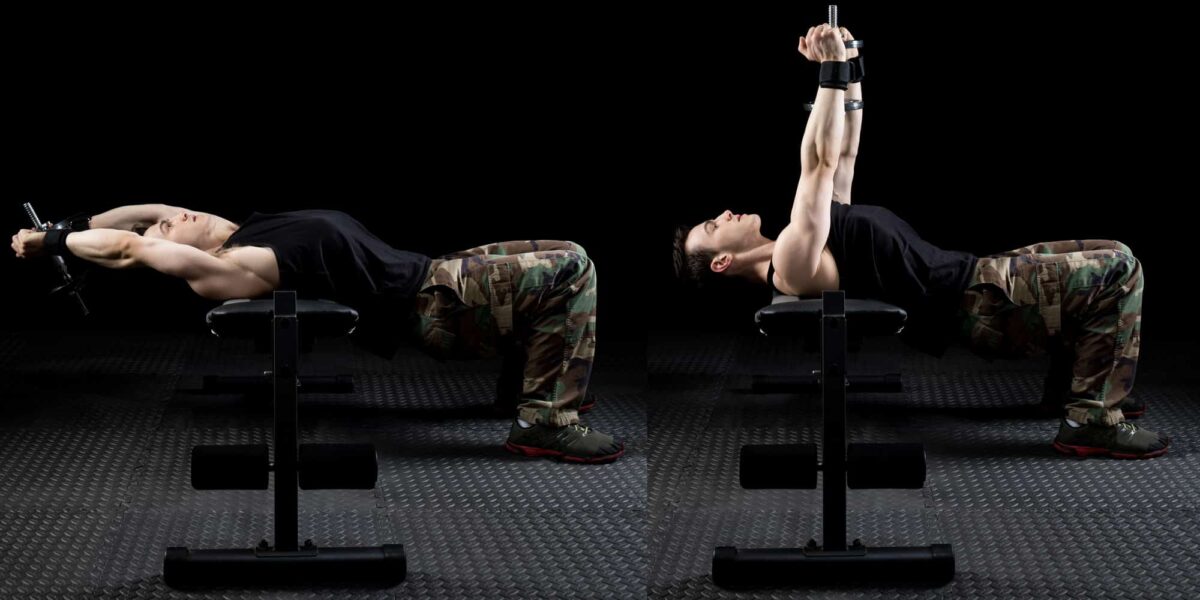
This exercise will change your position – it’s down on your back. And though it targets slightly different muscles from the previous exercises, lats are engaged no less. Even more, I’d say.
Dumbbell pullover engages:
- latissimus dorsi
- pectoralis major
- triceps
- serratus muscle (side of the ribcage)
How to do:
- Sit on a bench. Take one dumbbell in an overhand grip.
- Lie on your back. Dumbbell up and over your chest. Elbows bent. Back strong and anchored to the bench. Try not to bend in the lower back. Keep your neck straight to form a nice straight line.
- Engage your core and lats, and lower the dumbbell slowly behind your head.
- As your chest and lats are well stretched, pause for a second.
- Raise the dumbbell back up above your chest.
Renegade Row
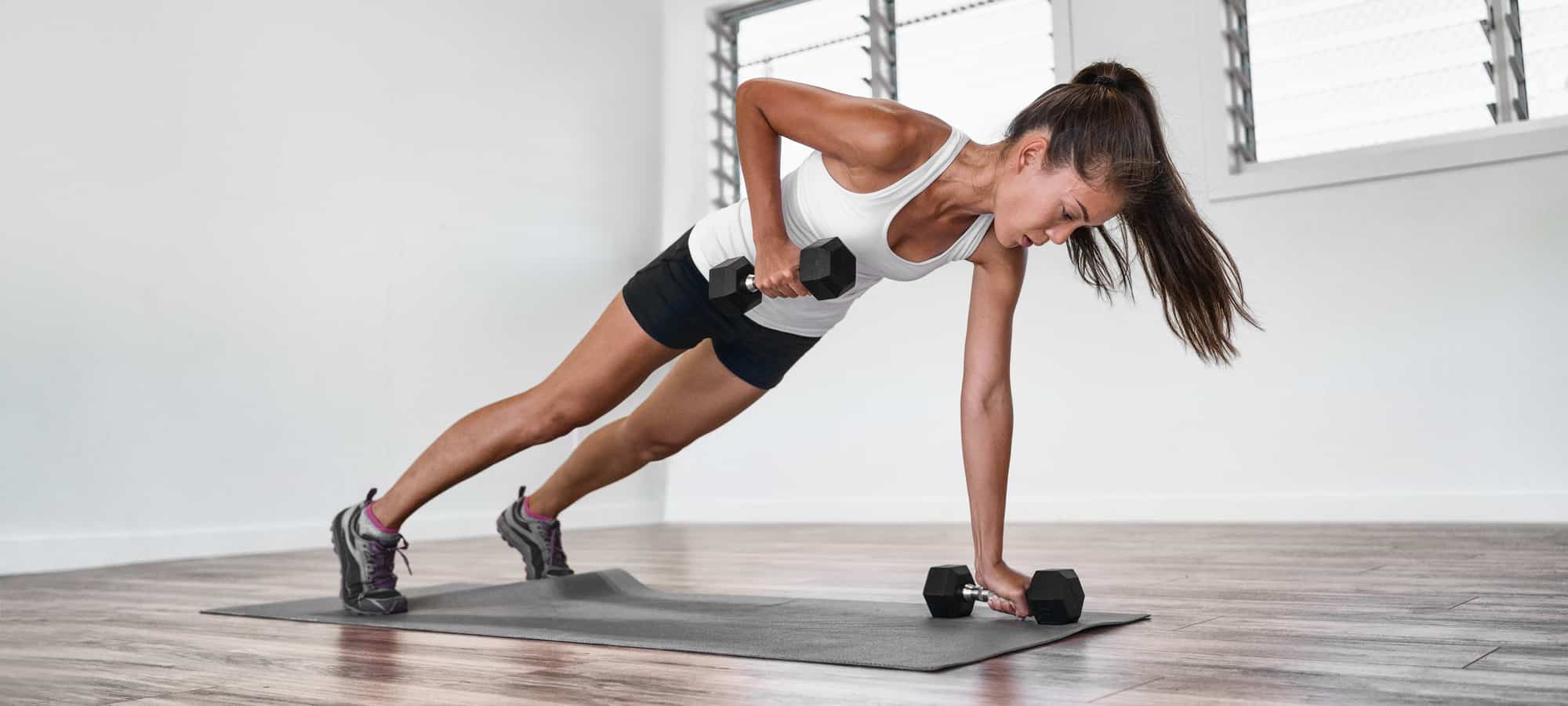
Let’s up the level of difficulty even more! This time, our core will do all the heavy-duty parts. Note that this exercise would be too hard for beginners. It’s suitable for either intermediate level or advanced athletes with heavy weights.
This exercise comes with many benefits at once, considering its compounds nature.
Overall, renegade raw engages:
- Latissimus dorsi
- Serratus
- Rhomboids
- Obliques
- Rectus abdominus
- Anterior deltoids
- Triceps
- Forearms
This is an impressive list, agree?
How to do:
- Stand in a plank position. Make sure you form a nice straight line from your ankles to your neck.
- Place dumbbells near your hands. And switch your hold to the dumbbell, so you are using them as “stilts.”
- Maintain a strong plank position and pull one dumbbell up to your chest while bending the elbow, following the movement pattern of the dumbbell row.
Seal Row
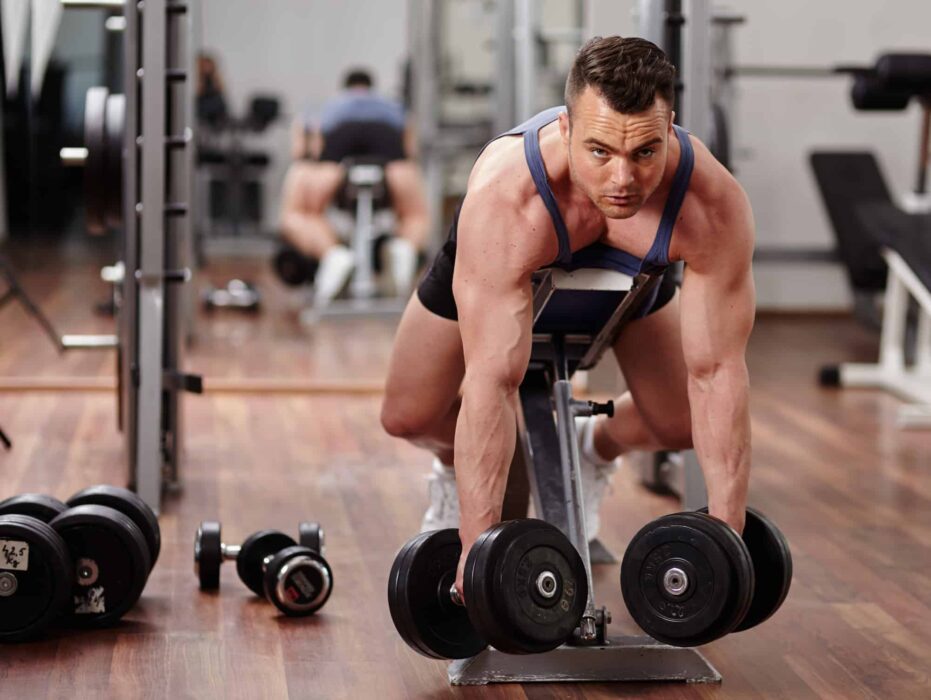
The dumbbell seal row is yet another row variation that helps cover each back muscle group and grow stronger. It is suitable for beginners as well, unlike the previous exercise. Although there are seal rower machines in gyms, many coaches I’ve talked with actually prefer the dumbbell version of the exercise. Plus, you can easily practice it at home.
Muscles engaged:
- latissimus dorsi
- trapezius
- rear deltoids
- biceps
- forearm flexors
How to do:
- Lie on your stomach on a straight bench. Arms on the sides of the bench. Look down so your neck remains in a neutral position.
- Take a dumbbell in each hand. Palms facing inward. Narrow grip.
- Lift the dumbbells towards your midsection, closer to your waist. Keep your elbows close to the body.
- Pause at the top and return to the starting position.
Pull-Ups (Weighted)
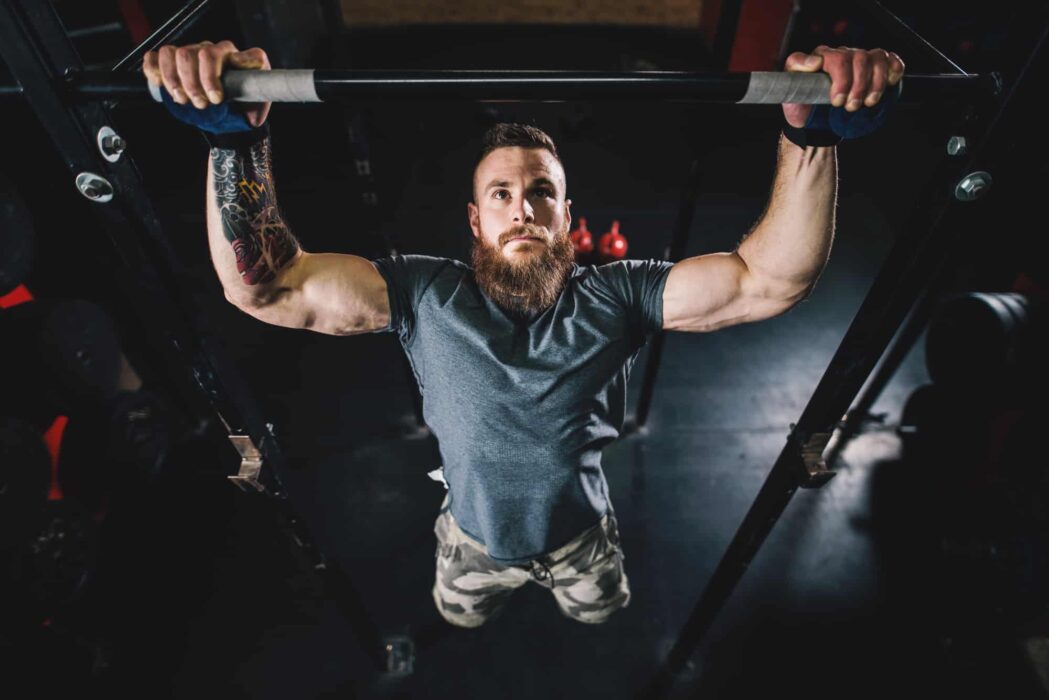
I suspect this is a surprise exercise on the list. Most of the previous movements were variations of rows. However, pull-ups are just as effective for lats as they are for the whole back! This is a compound exercise for an advanced level, requiring strong muscles. Weighted pull-ups should be your next step after you master the bodyweight pull-ups, and they don’t engage you enough.
11 Benefits of Pull-Ups You Could Be Missing Out On
Muscles engaged:
- Latissimus dorsi
- Biceps, brachioradialis, brachialis
- Deltoids
- Trapezius
- Teres major
- Rhomboids
- External obliques
- Thoracic spinae erectors
As you see, lats receive a big load of the weight and work!
How to do:
- Place a dumbbell between your ankles in a stable and comfortable position!
- Grasp the bar a bit wider than shoulder-width apart as you do for a regular pull-up.
- Engage your back and raise your torso towards the bar until your chin goes above the bar. Pause for a second and slowly lower.
Landmine Row (With Dumbbell)
Traditionally, this exercise is done with a barbell. However, most beginners don’t have a barbell at home. Dumbbells are easier to obtain and store. They are more apartment-friendly. However, it doesn’t mean that you cannot enjoy the landmine row at home (without the landmine). Just switch the equipment.
Landmine row engages:
- deltoids
- trapezius
- erector spinae
- latissimus dorsi
- glutes
How to do:
- Stand with feet shoulder-width apart. A barbell in front of you.
- Pick up the dumbbell with both hands. Bend at your hips for around 45-degrees. Back straight. Knees bent.
- Pull the dumbbell up to your chest. Elbows close to your body.
- Lower the dumbbell.
You can also check 11 best alternatives to cable row in my previous article! Any of them targets your back and lats.
Sources:
- Juan C. Chachques, Paul Chekroun, Paula Dardan, Edmundo C. Fischer and Alain Carpentier. Latissimus Dorsi Muscle Strengthening and Training before Cardiomyoplasty – (1997, Department of Cardiovascular Surgery, Broussais Hospital, Paris)
- Jeno, Susan & Varacallo, Matthew. Anatomy, Back, Latissimus Dorsi – StatPearls – A service of the National Library of Medicine, National Institutes of Health. Treasure Island (FL): StatPearls Publishing; 2018 Jan
- Lehman, Gregory & Buchan, Day & Lundy, Angela & Myers, Nicole & Nalborczyk, Andrea. Variations in muscle activation levels during traditional latissimus dorsi weight training exercises: An experimental study. – (2004, Dynamic medicine : DM. 3. 4. 10.1186/1476-5918-3-4.)
- Andersen, Vidar & Fimland, Marius & Wiik, Espen & Skoglund, Anders & Saeterbakken, Atle. Effects of Grip Width on Muscle Strength and Activation in the Lat Pull-Down. – (2014, Journal of strength and conditioning research / National Strength & Conditioning Association. 28. 1135-42. 10.1097/JSC.0000000000000232.)
- Holly Edelburg, B.S., John P. Porcari, Ph.D., Clayton Camic, Ph.D., Attila Kovacs, Ph.D., and Carl Foster, Ph.D., with Daniel J. Green. ACE-SPONSORED RESEARCH: What Is the Best Back Exercise? (2018, AceFitness)
- Ronai, Peter. The Barbell Row Exercise. – (2017, ACSMʼs Health & Fitness Journal. 21. 25-28. 10.1249/FIT.0000000000000278)
- Camara, Kevin & Coburn, Jared & Dunnick, Dustin & Brown, Lee & Costa, Pablo & Galpin, Andrew. An Examination Of Muscle Activation And Power Characteristics While Performing The Deadlift Exercise With Straight And Hexagonal Barbells. – (2016, The Journal of Strength and Conditioning Research. 30. 1183-1188. 10.1519/JSC.0000000000001352.)
- Marchetti, Paulo & Uchida, Marco C. Effects of the Pullover Exercise on the Pectoralis Major and Latissimus Dorsi Muscles as Evaluated by EMG. (2011, Journal of applied biomechanics. 27. 380-4. 10.1123/jab.27.4.380.)
 Fact checked by
Fact checked by